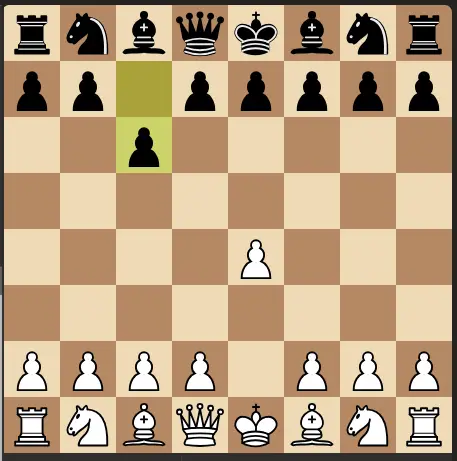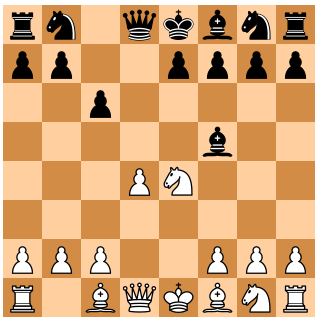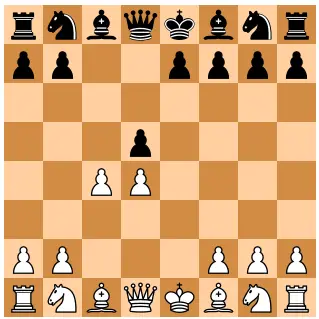The Caro-Kann Defense is a well-established and strategic chess opening that arises after the initial moves 1.e4 c6. Named after Horatio Caro and Marcus Kann, who were early proponents of this defense, it is renowned for its solid and resilient nature.
Starting position of the Caro-Kann Defense

By advancing the pawn to c6, Black seeks to create a sturdy foundation while carefully preparing to contest the center and launch counterattacks.
This opening’s emphasis on sound pawn structure and gradual piece development has made it a popular choice for players seeking a balanced and flexible approach against 1.e4.
Let’s dive deeper into this opening strategy and discuss some of it’s popular variations.
Strategy In The Caro-Kann Defense
The Caro-Kann is renowned for its solidity and security, boasting an enhanced pawn structure that frequently paves the way for favorable endgames.
Nonetheless, White enjoys an array of potential responses, which could potentially lead to swifter development than Black’s. Within the realm of Semi-Open games, this opening is generally regarded as less dynamic compared to the Sicilian and the French.
In the classic Open Game (1. e4 e5), numerous significant threats that Black might encounter are geared towards exploiting the vulnerable f7-square, often propelled by White’s bishop positioned at c4. By advancing their queen’s pawn to d5, Black can often mitigate this peril.
Hence, the core concept behind both the Caro-Kann and the French Defense is to establish early support for a d5-advanced queen’s pawn. The Caro-Kann accomplishes this through 1…c6, whereas the French does so by adopting 1…e6.
In embracing the Caro-Kann, Black willingly relinquishes central control in exchange for smoother development.
A common strategy is for Black to induce White’s pawns into overextension or fostering an unfavorable pawn structure, subsequently exploiting these weaknesses during the endgame phase.
Differing from the French Defense, the queen’s bishop in the Caro-Kann isn’t obstructed by a pawn on e6. However, this alternative opening choice closes off the c6-square for the knight’s advance.
Advanced Variation ( 1.e4 c6 2.d4 d5 3.e5)

By opting for 3.e5 in the Caro-Kann, White establishes a spatial edge by constructing a pawn chain within Black’s territory on the board’s half.
This choice locks down the center, inducing a deceleration in the position’s pace. This scenario opens the door for intricate strategic maneuvering on both flanks, leading to a complex situation.
Additionally, White has the opportunity to pursue aggressive lines of attack, further adding to the depth of the game.
Classical Variation (3…dxe4 4.Nxe4 Bf5)

The usual way to play the Caro–Kann chess opening, known as the Classical Variation (sometimes called the Capablanca Variation after the chess player José Raúl Capablanca), goes like this: First, 1.e4 c6 2.d4 d5 3.Nc3 (or 3.Nd2) dxe4 4.Nxe4 Bf5.
This was considered the best strategy for both players in the Caro–Kann opening. After that, White usually does: 5.Ng3 Bg6 6.h4 h6 7.Nf3 Nd7 8.h5 Bh7 9.Bd3 Bxd3 10.Qxd3.
Even though White’s pawn on h5 might seem ready to attack, it could end up being a problem in the later part of the game.
Exchange Variation (3.exd5 cxd5)

The Exchange Variation kicks off with 4.Bd3 (which stops …Bf5 while also aiding development), followed by 4…Nc6 5.c3 Nf6 6.Bf4 Bg4 7.Qb3.
In this version of the Caro-Kann, White addresses the challenge of potentially losing the e4 pawn by seizing on d5. Subsequently, they proceed with uncomplicated development, such as 4.Bd3, instead of opting for 4.c4 (which would lead to the Panov-Botvinnik attack).
This sequence is seen as giving White a slightly improved position and was experimented with by Bobby Fischer. Several of the strategic concepts resemble those in the Queen’s Gambit Declined, Exchange Variation (1.d4 d5 2.c4 e6 3.Nc3 Nf6 4.cxd5 exd5) but with the colors reversed.
Panov–Botvinnik Attack (4.c4)

The Panov–Botvinnik Attack kicks off with the move 4.c4. It takes its name from Vasily Panov and the world champion Mikhail Botvinnik.
This strategy frequently leads to typical positions featuring an isolated queen’s pawn (IQP), with White achieving swift development, control over e5, and potential for kingside attacks to offset the long-term structural vulnerability posed by the isolated d4-pawn.
The main route within this approach is 4…Nf6 5.Nc3 e6 6.Nf3, wherein Black’s primary choices are 6…Bb4 (a position often transitioning into Nimzo-Indian Defense lines) and 6…Be7, which used to be the most common choice.
6…Nc6?! is considered weaker since it is effectively countered by 7.c5!, a move that paves the way for White to secure the e5-square either by advancing the b-pawn to b5 or by trading off the black knight on c6 after Bb5.
Karpov Variation (3…dxe4 4.Nxe4 Nd7)

Another stable positional option, this variation is marked by the sequence: 1.e4 c6 2.d4 d5 3.Nc3 (or 3.Nd2) dxe4 4.Nxe4 Nd7.
While once attributed to the first world champion Wilhelm Steinitz, it now bears multiple names, including the Smyslov Variation, named after the seventh world champion Vasily Smyslov who showcased it in several notable games, the Karpov Variation, tied to the twelfth world champion Anatoly Karpov who frequently employed it, and most commonly, the Modern Variation.
The immediate aim of 4…Nd7 is to simplify development by initiating the early exchange of a pair of knights, all without compromising the structural solidity of Black’s position.
The gameplay mirrors the Classical Variation, except that Black gains greater flexibility by deferring the bishop’s development, escaping the obligation of placing it on g6.
However, this newfound flexibility comes with a trade-off, as White benefits from enhanced maneuverability in claiming central space.
This often leads to the daring 5.Ng5!?, where both the adequacy of Black’s development and the vulnerability of the f7-square come under scrutiny.
It’s noteworthy that the renowned final game of the Deep Blue versus Garry Kasparov rematch, in which Kasparov made a known error and suffered defeat, unfolded in this precise line.
Final Verdict – Is the Caro-Kann good?
In conclusion, the Caro-Kann Defense stands as a steadfast and strategic weapon in the world of chess openings.
Its solid foundation, built upon the move 1.e4 c6, offers players a reliable means of contending with the 1.e4 opening by White.
With a focus on maintaining a robust pawn structure and a well-thought-out piece development, the Caro-Kann provides a balanced and adaptable approach for those who appreciate strategic maneuvering and long-term positional play on the chessboard.
As a versatile option that has stood the test of time, the Caro-Kann continues to be a favorite among chess enthusiasts seeking a resilient and effective defense.


